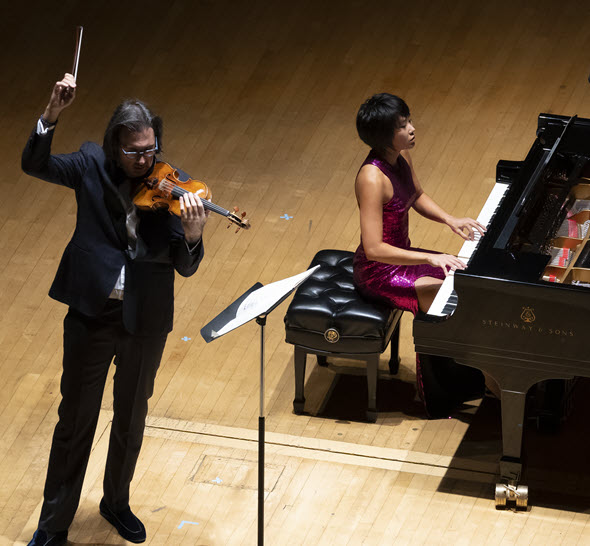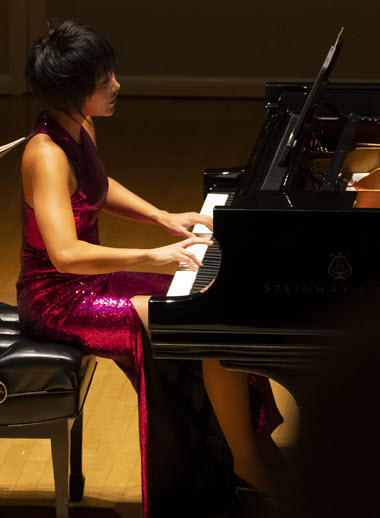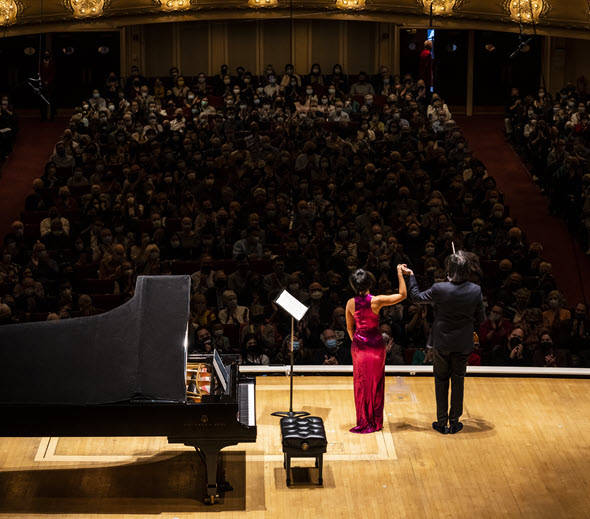Brilliance times two: Violin-piano recital casts light into dark and turbulent places of the soul

Violinist Leonidas Kavakos and pianist Yuja Wang performed duo sonatas at Orchestra Hall. (Photos by Todd Rosenberg)
Review: Violinist Leonidas Kavakos and pianist Yuja Wang at Orchestra Hall.
By Lawrence B. Johnson
As a duo, violinist Leonidas Kavakos and pianist Yuja Wang, two formidable virtuosi in their own right, are nothing short of fierce – or, in optional terms less feral: incandescent, mesmerizing, spectacular.
Such were the qualities of their recital together the afternoon of Nov. 7 at Orchestra Hall, a program of remarkable intensity and seriousness, but notable as well for its splendor and its sheer power. Kavakos, a tall sort of latter-day Paganini in aspect as well as accomplishment, and Wang, petite and absolutely authoritative at the keyboard, put together a singular program of sonatas by J.S. Bach, Ferruccio Busoni and Dmitri Shostakovich – a prospect that drew a near-capacity audience that sat in pin-drop quiet for an hour and 45 minutes sans intermission.
Bach’s six sonatas for keyboard and violin have perhaps always languished in the shadow of his famous half-dozen sonatas and partitas for solo violin. The movement sequence of slow-fast-slow-fast, typical of the pre-Classical sonata, tends in Bach’s duo sonatas to push the central weight of the piece to the second Adagio before the release afforded by a sprightly final Allegro. In any case, that’s the arc of Bach’s Sonata in E major, BWV 1016. Here, against Wang’s sparkling counterpoint, Kavakos imbued the ruminative line of the third movement not only with transcendent light, but also profound warmth, as if it were a soaring aria from a passion or cantata. And then off they skittered together, violinist and pianist, bounding across the final movement with unfettered joy and unfailing grace.
All three works on the program began in expansive introspection. Busoni’s Sonata No. 2 (1898) almost immediately harkens back to Brahms (who had died only the year before), both in its harmonic scheme and in its searing lyricism. Kavakos and Wang served it up with equal parts of indulgence and brilliance.
An expansive and technically imposing work in four movements essentially played without pause, Busoni’s Sonata progresses from a reflective opening section to a heady Presto before, not unlike the Bach, settling onto the broad and rigorous plane of its purpose – with a luminous section that leads directly into a series of variations, dark and exquisite, to which these musicians brought great concentration, fluency and the kind of conditioned teamwork that takes the listener into a work’s poetic interior.
If the program found the musicians progressing from strength to strength, it also took listeners to ever more transcendent spheres of engagement: From the distilled opulence of Busoni’s music, Kavakos and Wang plunged into the anguished heart of Shostakovich’s Violin Sonata, Op. 134. Shostakovich wrote the piece, exemplary of the dark and troubled strain that runs through his chamber music, as a 60th birthday tribute to his friend, violinist David Oistrakh. Think of the way Mahler flipped the children’s song “Frere Jacques” into the minor mode in his First Symphony, and you’ll have a pretty good idea of how Shostakovich’s Violin Sonata subverts the usual idea of happy birthday. But Oistrakh must have been thrilled. This quasi-expressionist emotional bender is a towering work.
From the opening Andante – the Sonata’s three movements progress slow-fast-slow – Wang’s powerful and fleet hands answered the sorrowing lines elicited by Kavakos. Shostakovich paints a world cast in deep shadows, a threatening and melancholy place, and the two musicians ventured there with intellectual conviction and fearlessness. The work’s central Allegro is one of those bounding Shostkovich’s essays that hovers on the line between exultation and angst, and thus Kavakos and Wang attacked it with brash confidence, perhaps leaving the listeners to decide. But there was no ambiguity in the long closing Largo: It is the bleak music of heartbreak, which violinist and pianist charged with riveting concentration – a level of intensity almost beyond tolerance but at the same impossible to deflect.
And there the recital ended, or nearly so. The audience, no doubt happy to stand at last, was quickly on its feet and vociferous in its enthusiasm. Kavakos and Wang obliged with an encore, an agile and witty turn through Stravinsky’s Dithyrambe from the Duo Concertante – the reassurance of light for all those who together had ventured down the tunnel.
Kavakos, who played Brahms’ Violin Concerto earlier this fall with the Chicago Symphony Orchestra under Riccardo Muti, returns for a third visit to play an evening of Beethoven piano trios with pianist Emanuel Ax and cellist Yo-Yo Ma at Orchestra Hall on March 11, 2022. Wang comes back for a solo recital at Orchestra Hall on April 10, 2022.





